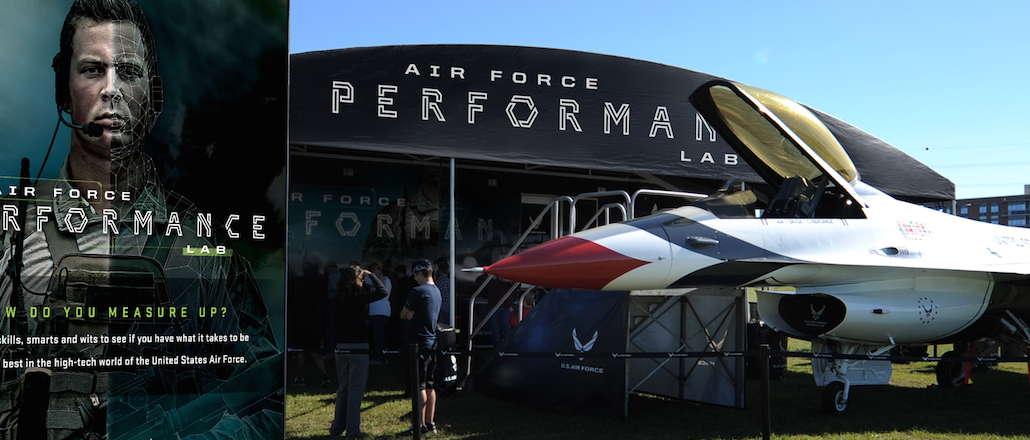
The U.S. Air Force is on the offensive — not on any battlefield but right here within our own borders.
The Air Force’s latest recruitment drive is a traveling experiential event packed with futuristic games and experiences to attract tech-minded youth at high schools, state fairs and air shows across the country.

The “Air Force Performance Lab,” unveiled this past Memorial Day weekend in Columbia, Missouri, employs a wide array of technologies that are designed to test different skills in potential recruits, including spatial and mechanical skills, dexterity, situational awareness, logic and reasoning and physical strength. The results of each challenge are then mapped over different Air Force careers that might suit the recruit.
“Since the Air Force mission relies on having the most updated technology, it’s imperative that our recruiting assets also reflect the fact that the Air Force continually strives to be highly technical,” said Major Jacob Chisolm, Chief of the Air Force National Events Branch. “We want them to walk away from the experience with new-found ideas of what the Air Force has to offer.”
A pull-up bar challenge, for instance, uses Kinect 2 technology for a test in which participants have 30 seconds to complete as many pull-ups as possible. There’s a flight simulator that uses Oculus Rift technology to virtually test individuals’ piloting potential. The tour also features several other touchscreen games including one that gives a real-life view of an Air Force Mission as well as a model F-16 Thunderbird plane.

Created in collaboration with agency GSD&M and other partners including Next Marketing, FISH Technologies, Craftsmen Industries and Reel FX, the test tracks an individual through RFID technology to collect, consolidate and compute his scores into a personalized assessment. It then displays the results on an on-site leaderboard in real-time.
“We’re always in a dilemma about the best way to grab the attention of these 16- to 24-year-olds,” said Tom Gilmore, GSD&M’s group creative director. “So we’re not only coming up with new technology but also other new ways to engage with them. The leaderboard works because most of them are very competitive.”

For 2015, the Air Force Recruiting Service is hiring over 21,000 new Airmen. But over the past few years, it has prioritized recruitment through mobile tours. Since 2010, the Air Force has experimented with several technologies in its tours and had more than 270,000 people register across five mobile tours, which have garnered more than 40,000 qualified leads for recruiters.
According to figures from the Government Accountability Office at the Department of Defense from 2013, 100 percent of the target recruitment goals were achieved that year and in the years preceding it, so the focus is now on quality STEM recruits.
“A lot of people have misconceptions about what it’s like to be in the Air Force,” said Cheyenne Gallion, GSD&M’s associate creative director. “We’re competing with the Googles and the Apples of the world for the talent pool.”
Other armed forces have also been experimenting with technology for recruiting. The U.S. Army, for example, introduced a “chatbot” designed to influence potential recruits to enlist in the Army last summer.
The success of these tours continues to provide Air Force recruiters with high-quality leads. The tests appear to have resonated. People are spending about 15 minutes on these experiences on average across tours, according to the Air Force. At the Missouri tour last weekend itself, there were 599 registrants, 72 of whom were considered “qualified leads,” or those who “meet the moral, physical and mental standards” of the Air Force.
More in Marketing

For platforms, here’s what’s not going to happen in 2026
Rather than the traditional platform predictions, this is a list of what Digiday believes won’t happen next year.

Cheez-It bets on ‘Prince Cheddward’ mascot in an overcrowded sports marketing arena
To cut through sports marketing noise, Cheez-It is resurrecting Prince Cheddward and betting on nostalgia.

The anatomy of an agency chief client officer
Several major agencies have moved to appoint chief client officers to their top cohorts lately.





